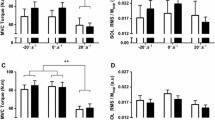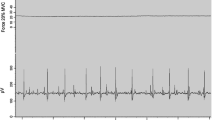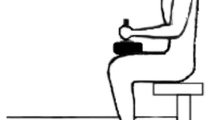Summary
Tendon (T-) and Hoffmann (H-) responses in the soleus muscle were quantified either separately or in association to compare the mononeurons activated and to study their changes after a period of endurance training. In a first experiment T- and H-responses of the same amplitude were compared: the electrical stimulus (inducing the H-response) and the Achilles tendon tap (inducing the T-response) were associated so that the T-response firstly was concomitant with the H-response, and secondly shifted 10 ms forward or back compared to the H-response. From the study of these combined reflexes we would suggest that the same motoneurons are involved in T- or H-responses of the same amplitude. In a second experiment the maximal H-responses, the T-responses and maximal aerobic power (W aer,max) were measured on 20 subjects before and after a period of endurance training. For 75% of the subjects the W aer,max and the reflex parameters (T or H) varied in the same direction: most of them exhibited higher values of both W aer,max and reflex amplitudes while the others had W aer,max and reflex values hardly modified or decreased. The different effects of the training period could reflect the heterogeneity of the subject's status and involvement in sport. In most cases the T: Hmax ratios were also influenced, reflecting the fact that T- and H-responses were not identically affected by training. Thus it is suggested that an endurance training programme can influence not only the excitability of the motoneurons but also the response of the muscle receptors to stretch. An interpretation in terms of a change of spindle receptivity and/or a change in their recruitment due to a greater stiffness of the trained muscles is suggested.
Similar content being viewed by others
References
Astrand PO, Ryhming I (1954) A nomogram for calculation of aerobic capacity (physical fitness) from pulse rate during submaximal work. J Appl Physiol 7:218–221
Burke D, Gandevia SC, McKeon B (1983) The afferent volleys responsible for spinal proprioceptive reflexes in man. J Physiol (Lond) 339:535–552
Burke D, Gandevia SC, McKeon B (1984) Monosynaptic and oligosynaptic contributions to human ankle jerk and H-reflex. J Neurophysiol 52:435–448
Casabona A, Polizzi MC, Perciavalle V (1990) Differences in Hreflex between athletes trained for explosive contractions and non-trained subjects. Eur J Appl Physiol 61:26–32
Crone C, Hultborn H, Jespersen B, Nielsen J (1987) Reciprocal la inhibition between ankle flexors and extensors in man. J Physiol (Lond) 389:163–185
Day BL, Marsden CD, Obeso JA, Rothwell JC (1984) Reciprocal inhibition between the muscles of the human forearm. J Physiol (Lond) 349:519–534
Denny-Brown D (1929) On the nature of postural reflexes. Proc R Soc Lond [Biol] 104:252–301
Dirks SJ, Hutton RS (1984) Endurance training and short latency reflexes in man. Scand J Sports Sci 6:21–26
Edds MV (1950) Hypertrophy of nerve fibers to functionally overloaded muscles. J Comp Neurol 93:259–275
Enoka RM, Hutton RS, Eldred E (1980) Changes in excitability of tendon tap and Hoffmann reflexes following voluntary contractions. Electroencephalogr Clin Neurophysiol 48:664–672
Ginet J, Guilheneuc P, Prevot M, Vecchierini-Blineau F (1975) Etude comparative du recrutement de la réponse reflexe monosynaptique du soléaire (reflexe H) chez de sujets non entraînés et chez des sportifs. Méd Sport 49:55–64
Gollnick PD, Piehl K, Saubert CW, Armstrong RB, Saltin B (1974) Human soleus muscle: a comparison of fiber composition and enzyme activities with other leg muscles. Pflügers Arch 348:247–255
Goubel F, Marini JF (1987) Fibre type transition and stiffness modifications of soleus muscle of trained rats. Pflügers Arch 410:321–325
Häkkinen K, Komi PV (1986) Training-induced changes in neuromuscular performance under voluntary and reflex conditions. Eur J Appl Physiol 55:147–155
Henneman E, Mendell LM (1981) Functional organization of motoneuron pool and its inputs. In: Brooks VB (ed) The nervous system. Handbook of physiology, vol II, part 1. American Physiological Society, Bethesda, pp 509–595
Henneman E, Olson CB (1965) Relations between structure and function in the design of skeletal muscles. J Neurophysiol 28:581–598
Homma S, Nakajima Y, Hayashi K, Shito K, Sato K (1981) Area display of H, M and T waves. In: Taylor A, Prochazka A (eds) Muscle receptors and movement. MacMillan, London, pp 381–387
Hoppeler H (1988) Exercise-induced structural changes of skeletal muscle. ISI Atlas Sci Biochem 2:247–255
Hugon M (1973) Methodology of the Hoffmann reflex in man. In: Desmedt JE (ed) New developments in electromyography and clinical neurophysiology vol 3. Karger, Basel, pp 227–293
Johnson MA, Polgar J, Weightman D, Appleton D (1973) Data on the distribution of fiber types in thirty six human muscles: an autopsy study. J Neurol Sci 18:111–129
Kamen G, Taylor P, Beehler PJ (1984) Ulnar and posterior tibial nerve conduction velocity in athletes. Int J Sports Med 5:26–30
Koceja DM, Kamen G (1988) Conditioned patellar tendon reflexes in sprint- and endurance-trained athletes. Med Sci Sports Exerc 20:172–177
Le Bars R (1976) Le réflexe de Hoffmann chez un groupe de jeunes nageurs. Méd Sport 50:221–223
Macarez JA (1977) Activités physiques et réflexes monosynaptiques chez l'homme. Symbioses 9:171–180
Milner-Brown HS, Stein RB, Lee RG (1975) Synchronization of human motor units: possible roles of exercise and supraspinal reflexes. Electroencephalogr Clin Neurophysiol 38:245–254
Müller W (1974) Temporal progress of muscle adaptation to endurance training in hind limb muscles of young rats. A histochemical and morphometrical study. Cell Tissue Res 156:61–87
Nadeau M (1980) Neurostimulation. In: Nadeau M, Péronnet F (eds) Physiologie appliquée de l'activité physique. Edisem-Vigot, St. Hyacinthe, Québec, pp 241–253
Paillard J (1955) Reflexes et regulations d'origine proprioceptive chez l'homme. Thesis, Faculté des Sciences, Paris
Pette D (1984) Activity-induced fast to slow transitions in mammalian muscle. Med Sci Sport Med 16:517–528
Pierrot-Deseilligny E, Bussel B, Held JP, Katz R (1976) Excitability of human motoneurones after discharge in a conditionning reflex. Electroencephalogr Clin Neurophysiol 40:279–287
Rack PMH, Ross HF, Thilmann AF, Walters DKW (1983) Reflex responses at the human ankle: the importance of tendon compliance. J Physiol (Lond) 344:503–524
Rochcongar P, Dassonville Y, Le Bars R (1979) Modifications du reflex de Hoffmann en fonction de l'entraînement chez le sportif. Eur J Appl Physiol 40:165–170
Ryushi T, Fukunaga T, Yuasa K, Nakajima H (1990) The influence of motor unit composition and nature on fractionated patellar reflex times in untrained men. Eur J Appl Physiol 60:44–48
Sady SP, Carpenter MW, Sady MA, Haydon B, Hoegsberg B, Cullinane EM, Thompson PD, Constan DR (1988) Prediction of \(\dot VO_{2max}\)during cycle exercise in pregnant women. J Appl Physiol 65:657–661
Sale DG (1988) Neural adaptation to resistance training. Med Sci Sports Exerc 20:135–145
Sale D, McDougall JD, Upton ARM, McComas AJ (1983) Effects of strength training upon motoneuron excitability in man. Med Sci Sports Exerc 15:57–62
Saltin B, Gollnick PD (1983) Skeletal muscle adaptability: significance for metabolism and performance. In: Peachey LD (ed) Skeletal muscle. Handbook of physiology, section 10. American Physiological Society, Bethesda, pp 555–631
Van Boxtel A (1986) Differential effects of low-frequency depression vibration-induced inhibition, and posttetanic potentiation on H-reflexes and tendon jerks in the human soleus muscle. J Neurophysiol 55:551–568
Author information
Authors and Affiliations
Rights and permissions
About this article
Cite this article
Pérot, C., Goubel, F. & Mora, I. Quantification of T- and H-responses before and after a period of endurance training. Eur J Appl Physiol 63, 368–375 (1991). https://doi.org/10.1007/BF00364464
Accepted:
Issue Date:
DOI: https://doi.org/10.1007/BF00364464




